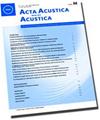Estimation of the Perceived Time of Presence of Sources in Urban Acoustic Environments Using Deep Learning Techniques
Q1 Arts and Humanities
引用次数: 11
Abstract
The impact of urban sound on human beings has often been studied from a negative point of view (noise pollution). In the two last decades, the interest of studying its positive impact has been revealed with the soundscape approach (resourcing spaces). The literature shows that the recognition of sources plays a great role in the way humans are affected by sound environments. There is thus a need for characterizing urban acoustic environments not only with sound pressure measurements but also with source-specific attributes such as their perceived time of presence, dominance or volume. This paper demonstrates, on a controlled dataset, that machine learning techniques based on state of the art neural architectures can predict the perceived time of presence of several sound sources at a sufficient accuracy. To validate this assertion, a corpus of simulated sound scenes is first designed. Perceptual attributes corresponding to those stimuli are gathered through a listening experiment. From the contributions of the individual sound sources available for the simulated corpus, a physical indicator approximating the perceived time of presence of sources is computed and used to train and evaluate a multi-label source detection model. This model predicts the presence of simultaneously active sources from fast third octave spectra, allowing the estimation of perceptual attributes such as pleasantness in urban sound environments at a sufficient degree of precision.利用深度学习技术估计城市声环境中声源存在的感知时间
城市声音对人类的影响通常是从消极的角度(噪音污染)来研究的。在过去的二十年里,研究其积极影响的兴趣已经随着声景方法(资源空间)而显露出来。文献表明,对声源的识别在人类受声音环境影响的方式中起着重要作用。因此,不仅需要用声压测量来描述城市声学环境,而且需要用特定于声源的属性来描述城市声学环境,例如它们感知到的存在时间、主导地位或音量。本文在一个受控数据集上证明,基于最先进的神经结构的机器学习技术可以以足够的精度预测几个声源存在的感知时间。为了验证这一断言,首先设计了一个模拟声音场景的语料库。与这些刺激相对应的知觉属性是通过听觉实验收集的。根据模拟语料库中可用的单个声源的贡献,计算近似声源存在的感知时间的物理指标,并用于训练和评估多标签声源检测模型。该模型预测了来自快速三倍频度频谱的同时活跃源的存在,允许以足够的精度估计感知属性,例如城市声音环境中的愉悦度。
本文章由计算机程序翻译,如有差异,请以英文原文为准。
求助全文
约1分钟内获得全文
求助全文
来源期刊
CiteScore
2.60
自引率
0.00%
发文量
0
审稿时长
6.8 months
期刊介绍:
Cessation. Acta Acustica united with Acustica (Acta Acust united Ac), was published together with the European Acoustics Association (EAA). It was an international, peer-reviewed journal on acoustics. It published original articles on all subjects in the field of acoustics, such as
• General Linear Acoustics, • Nonlinear Acoustics, Macrosonics, • Aeroacoustics, • Atmospheric Sound, • Underwater Sound, • Ultrasonics, • Physical Acoustics, • Structural Acoustics, • Noise Control, • Active Control, • Environmental Noise, • Building Acoustics, • Room Acoustics, • Acoustic Materials and Metamaterials, • Audio Signal Processing and Transducers, • Computational and Numerical Acoustics, • Hearing, Audiology and Psychoacoustics, • Speech,
• Musical Acoustics, • Virtual Acoustics, • Auditory Quality of Systems, • Animal Bioacoustics, • History of Acoustics.

 求助内容:
求助内容: 应助结果提醒方式:
应助结果提醒方式:


